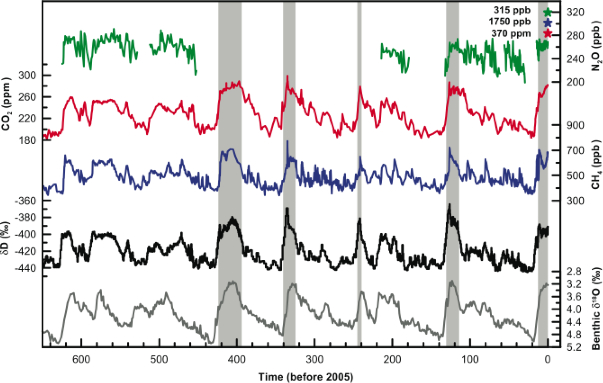
|

|


Paleoclimate
How do we know about the Ice Ages?
Greenhouse Gases and the Ice Ages
 The first three lines in this same figure are
greenhouse gases - nitrous oxide (N2O, green), carbon dioxide (CO2, red),
and
methane
(CH4, blue). Note that the present concentrations of these gases in
our atmosphere are higher than at any point in the 650,000-year record. During
the relatively warm periods of the interglacials, marked by gray shading, the
concentrations of carbon dioxide and methane are noticeably higher than during
glacial periods.
The first three lines in this same figure are
greenhouse gases - nitrous oxide (N2O, green), carbon dioxide (CO2, red),
and
methane
(CH4, blue). Note that the present concentrations of these gases in
our atmosphere are higher than at any point in the 650,000-year record. During
the relatively warm periods of the interglacials, marked by gray shading, the
concentrations of carbon dioxide and methane are noticeably higher than during
glacial periods.
The Ice Ages were most likely caused by the Milankovitch Cycles, which affect how much radiation the northern latitudes receive during the summer. The abrupt ends to each of the glacial periods in this graph are probably due to a feedback loop. First, summertime temperatures increased, resulting in melting ice. As the ice sheets melted, more solar radiation was absorbed by the surface, resulting in warmer temperatures and less ice. Also as temperatures rose, the amount of carbon dioxide the oceans were able to store decreased, which explains at least some of the rising CO2 during interglacial periods.
However, the current warming we are experiencing is different from the warming that caused the Ice Ages to end. The Earth's orbit is already situated to give us warm temperatures, which is why we are no longer in an ice age. Whereas at the end of glacial periods, rising greenhouse gases follow warming, currently greenhouse gases are rising and a global warming is resulting.
Back to climate topics
Links and resources
How do we know about the Ice Ages?
Greenhouse Gases and the Ice Ages
 The first three lines in this same figure are
greenhouse gases - nitrous oxide (N2O, green), carbon dioxide (CO2, red),
and
methane
(CH4, blue). Note that the present concentrations of these gases in
our atmosphere are higher than at any point in the 650,000-year record. During
the relatively warm periods of the interglacials, marked by gray shading, the
concentrations of carbon dioxide and methane are noticeably higher than during
glacial periods.
The first three lines in this same figure are
greenhouse gases - nitrous oxide (N2O, green), carbon dioxide (CO2, red),
and
methane
(CH4, blue). Note that the present concentrations of these gases in
our atmosphere are higher than at any point in the 650,000-year record. During
the relatively warm periods of the interglacials, marked by gray shading, the
concentrations of carbon dioxide and methane are noticeably higher than during
glacial periods. The Ice Ages were most likely caused by the Milankovitch Cycles, which affect how much radiation the northern latitudes receive during the summer. The abrupt ends to each of the glacial periods in this graph are probably due to a feedback loop. First, summertime temperatures increased, resulting in melting ice. As the ice sheets melted, more solar radiation was absorbed by the surface, resulting in warmer temperatures and less ice. Also as temperatures rose, the amount of carbon dioxide the oceans were able to store decreased, which explains at least some of the rising CO2 during interglacial periods.
However, the current warming we are experiencing is different from the warming that caused the Ice Ages to end. The Earth's orbit is already situated to give us warm temperatures, which is why we are no longer in an ice age. Whereas at the end of glacial periods, rising greenhouse gases follow warming, currently greenhouse gases are rising and a global warming is resulting.
Back to climate topics
Links and resources
